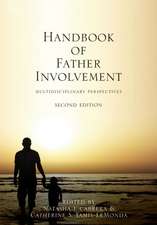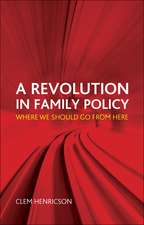Handbook of Measurement Issues in Family Research
Editat de Sandra L. Hofferth, Lynne M. Casperen Limba Engleză Paperback – 14 dec 2012
This authoritative volume offers a blueprint for addressing some of the most important measurement issues in family research, and it points out potential pitfalls for researchers and students who may not be familiar with data quality issues.
The Handbook of Measurement Issues in Family Research will appeal to scholars in the departments of psychology, sociology, and population studies, as well as researchers working in governmental agencies.
| Toate formatele și edițiile | Preț | Express |
|---|---|---|
| Paperback (1) | 339.52 lei 6-8 săpt. | |
| Taylor & Francis – 14 dec 2012 | 339.52 lei 6-8 săpt. | |
| Hardback (1) | 608.98 lei 6-8 săpt. | |
| Taylor & Francis – 26 iun 2006 | 608.98 lei 6-8 săpt. |
Preț: 339.52 lei
Nou
Puncte Express: 509
Preț estimativ în valută:
64.99€ • 70.61$ • 54.62£
64.99€ • 70.61$ • 54.62£
Carte tipărită la comandă
Livrare economică 21 aprilie-05 mai
Preluare comenzi: 021 569.72.76
Specificații
ISBN-13: 9780415648219
ISBN-10: 0415648211
Pagini: 514
Dimensiuni: 152 x 229 x 26 mm
Greutate: 0.68 kg
Ediția:1
Editura: Taylor & Francis
Colecția Routledge
Locul publicării:Oxford, United Kingdom
ISBN-10: 0415648211
Pagini: 514
Dimensiuni: 152 x 229 x 26 mm
Greutate: 0.68 kg
Ediția:1
Editura: Taylor & Francis
Colecția Routledge
Locul publicării:Oxford, United Kingdom
Public țintă
ProfessionalCuprins
Contents: Preface. Part I: Introduction. L.M. Casper, S.L. Hofferth, Playing Catch-Up: Improving Data and Measures for Family Research. Part II: Marriage and Cohabitation. J.T. Knab, S. McLanahan, Measuring Cohabitation: Does How, When, and Who You Ask Matter? M.S. Pollard, K.M. Harris, Measuring Cohabitation in Add Health. P.R. Amato, Studying Marriage and Commitment With Survey Data. A.J. Hawkins, B.J. Fowers, J.S. Carroll, C. Yang, Conceptualizing and Measuring Marital Virtues. S.M. Stanley, Assessing Couple and Marital Relationships: Beyond Form and Toward a Deeper Knowledge of Function. K.A. Moore, J. Bronte-Tinkew, S. Jekielek, L. Guzman, S. Ryan, Z. Redd, J. Carrano, G. Matthews, Developing Measures of Healthy Marriages and Relationships. Part III: Separation and Divorce. L. Bumpass, K. Raley, Measuring Separation and Divorce. M. O'Connell, The Visible Hand: Editing Marital-History Data From Census Bureau Surveys. Part IV: Household Composition and Family Relationships. P.D. Brandon, Mapping Children's Living Arrangements With a Relationship Matrix. M. Hill, P. Callister, Is Single-Parent Family a Misnomer Misdirecting Research and Policies? W.D. Manning, R.E. Bulanda, Cohabitation and Measurement of Family Trajectories. J. Iceland, Measuring Poverty With Different Units of Analysis. G.J. Gates, R. Sell, Measuring Gay and Lesbian Couples. W.D. Mosher, Including the Military and the Incarcerated in Surveys of Families. Part V: Becoming a Father. F.L. Mott, D.S. Hurst, T. Gryn, Male Relationship and Fertility Data in the NLSY. S. Boggess, G. Martinez, C.B. Jasik, L.D. Lindberg, Counting Dads: Improving Estimates of Teen Fatherhood. W. Marsiglio, Qualitative Insights for Studying Male Fertility. C. Bachrach, Taking Stock: Do Surveys of Men's Fertility Deliver? Part VI: Fathers and Fathering. S.L. Hofferth, N. Cabrera, M. Carlson, R.L. Coley, R. Day, H. Schindler, Resident Father Involvement and Social Fathering. L. Argys, E. Peters, S. Cook, S. Garasky, L. Nepomnyaschy, E. Sorensen, Measuring Contact Between Children and Nonresident Fathers. S. Garasky, E. Peters, L. Argys, S. Cook, L. Nepomnyaschy, E. Sorensen, Measuring Support to Children by Nonresident Fathers. Part VII: Conclusion. S.L. Hofferth, L.M. Casper, Progress Made, Gaps Remain: Final Observations.
Notă biografică
Sandra L. Hofferth, Lynne M. Casper
Descriere
Over the past several decades, dramatic changes have reshaped America’s families. This authoritative volume offers a blueprint for addressing some of the most important measurement issues in family research, and it points out potential pitfalls for













